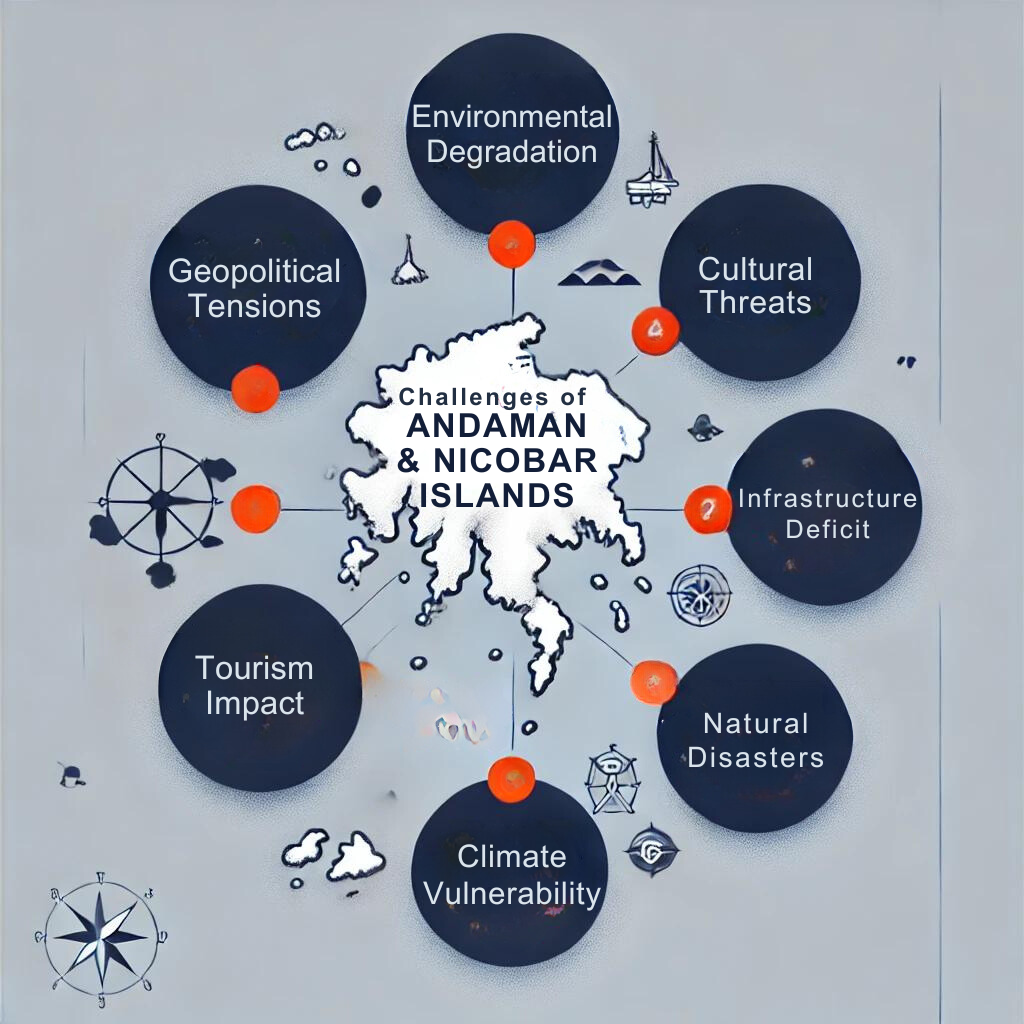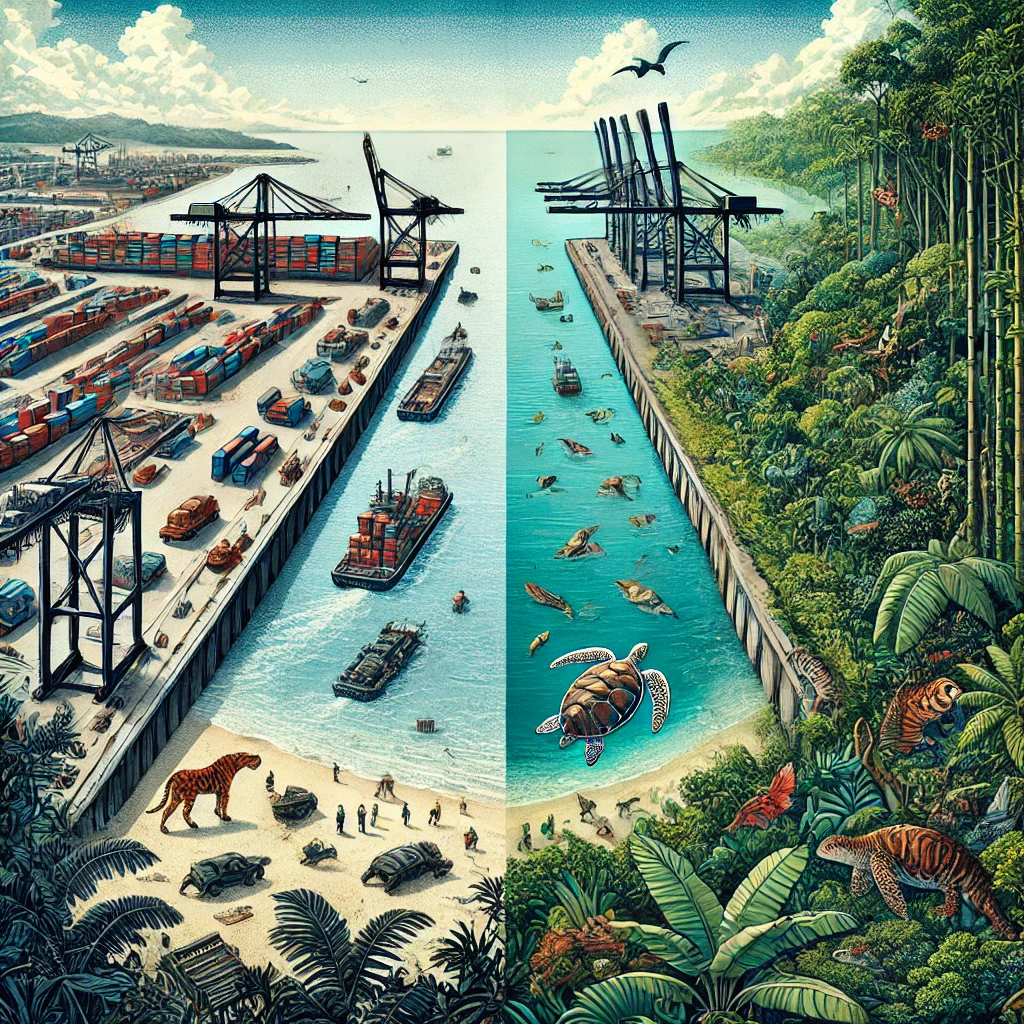The Great Nicobar Island Project, valued at Rs 42,000 crore, illustrates the ongoing conflict between India’s development goals and environmental preservation. Located in Galathea Bay, the project involves constructing a transshipment port in an area known for its rich biodiversity. Despite the presence of endangered species and vital ecosystems, authorities have made controversial decisions, such as denotifying a wildlife sanctuary and reclassifying coastal zones, to push the project forward. This case highlights the broader issue of weakening environmental regulations for large-scale developments, raising concerns about the long-term ecological costs and the integrity of India’s environmental protection framework.
| GS Paper | General Studies III |
| Topics for UPSC Prelims | Great Nicobar Island Project, Galathea Bay, Andaman and Nicobar Islands, Coral reefs, Act East policy, Andaman and Nicobar Command, 2004 Indian Ocean tsunami, Renewable energy, Malacca Strait, Intergovernmental Panel on Climate Change, El Nino Southern Oscillation. |
| Topics for UPSC Mains | Significance of Andaman and Nicobar Islands for India, Major Challenges Related to Andaman and Nicobar Islands. |
Origin of the Article
This editorial is based on “How a wildlife sanctuary in the Great Nicobar Island was made to vanish,” published in The Indian Express on 14/08/2024. The article focuses on environmental mismanagement and legal maneuvers affecting India’s coastal ecosystems, especially in the Andaman and Nicobar Islands.
Relevancy for UPSC Students
Understanding the balance between development and conservation is crucial for UPSC aspirants. This topic aligns with the UPSC syllabus under GS Paper 2 (Government Policies & Interventions) and GS Paper 3 (Environmental Pollution & Degradation). It helps students grasp the complexities of policy-making and environmental ethics, aiding in essay writing and general studies.
Why in News
The controversy surrounding the Great Nicobar Island Project is significant for UPSC aspirants as it touches upon multiple relevant themes such as environmental conservation, legal frameworks, and developmental policies. The case raises questions about the balance between economic development and ecological preservation, a topic frequently explored in UPSC exams. Previous questions on coral reefs, indigenous tribes like the Shompen, and the strategic importance of the Andaman and Nicobar Islands underscore the recurring relevance of these issues. Understanding this case can offer insights into the complexities of policy-making and environmental governance.
Significance of Andaman and Nicobar Islands for India
The Andaman and Nicobar Islands are of immense significance to India, impacting the nation’s economic, ecological, and geopolitical landscapes. These islands are not only a blue economic gateway but also an ecological treasure trove and a critical geopolitical asset. Their strategic location and rich biodiversity offer unique opportunities and responsibilities for sustainable development and conservation.
Blue Economic Gateway
The Andaman and Nicobar Islands are strategically located along major shipping routes, making them a vital link in global maritime trade. The proposed transshipment port in Great Nicobar could handle 4 million TEUs annually, positioning India as a significant player in global trade. Additionally, the islands offer vast opportunities in fishing, aquaculture, and marine biotechnology, contributing to India’s economic growth.
Ecological Treasure Trove
Home to over 9,100 species of fauna, the Andaman and Nicobar Islands are a biodiversity hotspot. The region boasts extensive coral reefs and unique species like the leatherback turtle and Nicobar megapode. This rich biodiversity not only supports scientific research but also underscores India’s role in global conservation efforts.
Geopolitical Leverage
The islands significantly extend India’s strategic reach into Southeast Asia, serving as a cornerstone for its Act East policy. Located just 90 nautical miles from Indonesia, they facilitate diplomatic, economic, and military engagement with ASEAN countries. The tri-service Andaman and Nicobar Command enhances India’s ability to project power and conduct joint operations, countering China’s ‘String of Pearls’ strategy.
First Responder in the Bay of Bengal
The islands play a crucial role in disaster management for the Bay of Bengal region, acting as an early warning system for tsunamis and cyclones. The Indian National Centre for Ocean Information Services (INCOIS) operates key monitoring stations here, which were instrumental during the 2004 Indian Ocean tsunami, coordinating relief efforts effectively.
Energy Security
The Andaman offshore basin holds significant hydrocarbon reserves, which could boost India’s energy security. The islands also have the potential for renewable energy, particularly ocean thermal energy conversion, and tidal power, presenting opportunities for sustainable energy development and innovation.
Cultural Melting Pot
The Andaman and Nicobar Islands are home to six indigenous tribes, including the Sentinelese, one of the world’s last uncontacted peoples. This cultural diversity is both a responsibility and an opportunity for India to preserve indigenous ways of life, showcasing its commitment to cultural preservation and inclusive development.
Major Challenges Related to Andaman and Nicobar Islands
The Andaman and Nicobar Islands face critical challenges in balancing development and conservation. These challenges encompass environmental degradation, geopolitical tensions, infrastructure deficits, and cultural preservation, among others. Addressing these issues is crucial for the islands’ sustainable development.

Paradise in Peril
The proposed Rs 42,000 crore transshipment port in Great Nicobar threatens critical habitats. The denotification of Galathea Bay Wildlife Sanctuary exemplifies the prioritization of development over conservation. Such trends could lead to irreversible ecological damage, impacting biodiversity and climate regulation.
Geopolitical Chessboard
The islands’ strategic location places them at the center of Indo-Pacific geopolitical tensions. China’s “String of Pearls” strategy and the proximity to the Malacca Strait, through which about 40% of India’s trade passes, pose significant security challenges, adding to the strategic complexity.
Infrastructure Deficit
Despite their strategic importance, the islands suffer from a severe infrastructure deficit. Only 38 out of 572 islands are inhabited, with limited connectivity between them. The capital, Port Blair, is over 1,200 km from the mainland, complicating logistics and resource allocation.
Cultural Crossroads
The indigenous tribes of the islands, including the Jarawa, Onge, and Sentinelese, face existential threats from modernization and outside contact. The population of the Great Andamanese has dwindled significantly, and the construction of the Andaman Trunk Road through Jarawa territory has led to increased interactions and potential exploitation.
Tourism Tightrope
Tourism, a major economic driver for the islands, brings economic benefits but also strains local resources and ecosystems. Developing sustainable tourism infrastructure, managing waste, and protecting sensitive areas are significant challenges that need to be addressed.
Climate Vulnerability
The islands are at the forefront of climate change impacts, facing threats from sea-level rise, increased cyclone intensity, and changing precipitation patterns. The IPCC warns of potential submergence of low-lying areas by 2050. Coral bleaching events also pose significant threats to marine biodiversity.
Natural Disaster Hotspot
Located in a seismically active zone, the islands are highly susceptible to earthquakes and tsunamis. The devastating 2004 Indian Ocean tsunami and subsequent seismic activities highlight this vulnerability. The islands are also prone to landslides, particularly during monsoon seasons.
PESTEL Analysis
| Political: The Andaman and Nicobar Islands are pivotal in India’s Act East policy, strategically countering China’s regional influence. Government decisions, such as declassifying wildlife sanctuaries for development projects like the Great Nicobar Island transshipment port, reflect a complex interplay of developmental ambitions and conservation needs. Economic: With the potential to boost India’s blue economy through the proposed port, which can handle significant container traffic and untapped hydrocarbon reserves, the economic prospects are substantial. However, infrastructural deficits and the need for sustainable tourism and fisheries management present economic challenges. Social: The presence of unique indigenous tribes adds a critical sociocultural dimension. Modernization poses threats to these communities, making cultural preservation essential. Sustainable tourism can promote conservation while respecting and integrating local cultures. Technological: Advancements in sustainable technology such as renewable energy sources, water conservation systems, and eco-friendly waste management are essential for environmentally responsible development. Enhanced internet connectivity is also vital for remote education and work. Environmental: Environmental concerns are paramount with the ongoing degradation due to development projects threatening the biodiversity that includes significant marine life and coral reefs. The islands are crucial for global biodiversity conservation efforts and require strict environmental regulations and rehabilitation initiatives. Legal: Legal challenges include adherence to environmental laws in the face of developmental pressures. The legal framework must balance development with environmental and cultural preservation, enforcing regulations that protect biodiversity and manage the impacts of climate change and natural disasters. |
Steps India Can Take Concerning the Andaman and Nicobar Islands
To ensure the sustainable development and security of the Andaman and Nicobar Islands, India must take actionable steps across various domains. These measures should focus on sustainable infrastructure, enhanced coastal protection, cultural preservation, and disaster resilience.
Sustainable Infrastructure Development
Implementing a comprehensive sustainable infrastructure plan prioritizes renewable energy, water conservation, and eco-friendly waste management. This includes developing solar and wind power installations, rainwater harvesting systems, and robust waste management systems, ensuring all new construction adheres to green building standards.
Enhanced Coastal and Marine Protection
Strengthening marine protected areas and investing in advanced monitoring technologies are crucial. Community-based conservation programs and comprehensive coral restoration efforts can protect endangered species and preserve marine biodiversity.
Cultural Sanctuaries
Creating buffer zones around indigenous territories and developing culturally sensitive healthcare programs are essential. Establishing an Indigenous Knowledge and Culture Center and implementing strict tourism regulations can help preserve traditional ways of life.
Green Tourism
A comprehensive ecotourism strategy, including certification programs for eco-friendly accommodations and conservation awareness initiatives, can promote sustainable tourism. Limiting visitor numbers based on carrying capacity studies ensures that tourism does not strain local resources and ecosystems.
Disaster Resilience
Developing a multi-hazard early warning system and implementing strict building codes are vital for disaster resilience. Creating disaster-resistant shelters, conducting regular community drills, and investing in nature-based solutions like mangrove restoration can enhance the islands’ capacity to withstand natural disasters.
Adaptive Strategies for Climate Change
Implementing climate change adaptation plans, including nature-based coastal defense systems and climate-resilient agriculture practices, is crucial. Establishing a dedicated climate change research station can monitor local impacts and develop tailored adaptation strategies.
Island Connectivity
Developing an integrated transportation system combining electric ferries, solar-powered water taxis, and eco-friendly land transport options can improve connectivity. A smart traffic management system can optimize vehicle flow and reduce emissions in urban areas.
Blue Economy Boost
Developing sustainable aquaculture projects, investing in seaweed farming, and establishing a marine biotechnology research center can boost the blue economy. Promoting sustainable fishing practices through training programs and market incentives ensures the long-term viability of marine resources.
Leveraging Technology for Island Development
Expanding high-speed internet connectivity and implementing IoT-based environmental monitoring systems can facilitate remote work and improve access to education and healthcare. These technological advancements can support the islands’ overall development and resilience.
Conclusion
The Andaman and Nicobar Islands serve as a microcosm of the delicate balance between development and conservation. As India moves forward with ambitious projects, it is crucial to ensure that environmental sustainability is not sacrificed for economic gains. UPSC aspirants must reflect on how policies can be crafted to protect such unique ecosystems while fostering growth, ultimately shaping a more harmonious future.
| UPSC Civil Services Examination, Previous Year Questions (PYQs) Mains Q. What are the strategic implications of Andaman and Nicobar Islands for India? Discuss the challenges of development while preserving the unique biodiversity of the region. (GS Paper III, 2023) Q. Evaluate the role of the Andaman and Nicobar Command in India’s defense strategy, especially in the context of the Malacca Strait’s strategic importance. How does this align with India’s Act East policy? |


